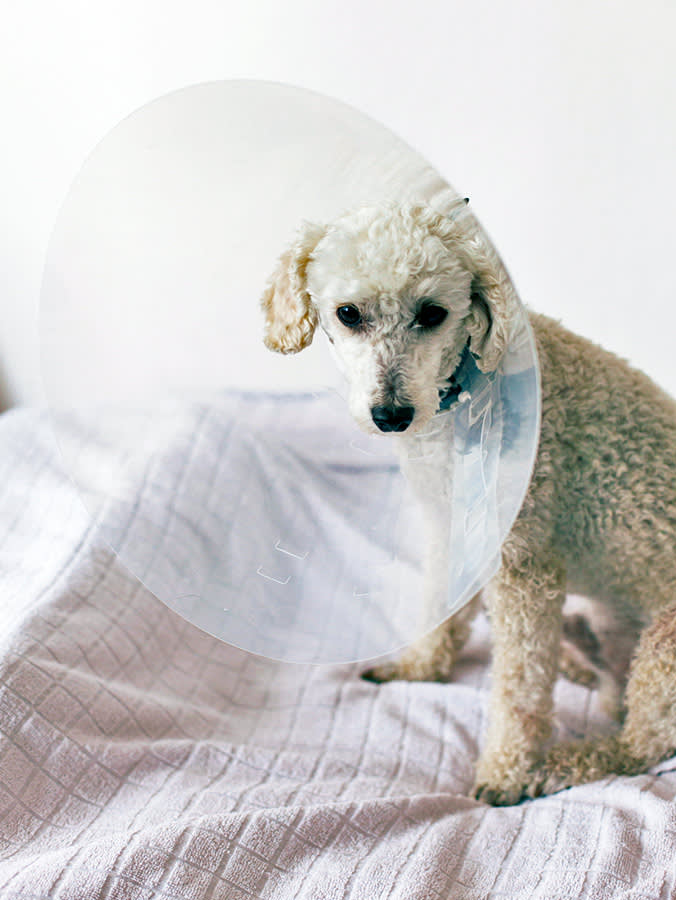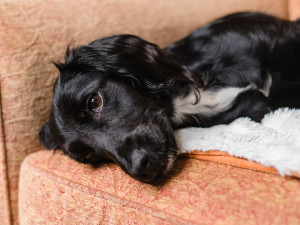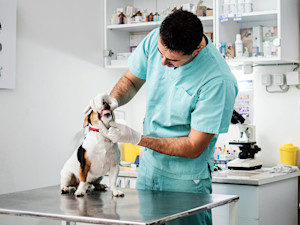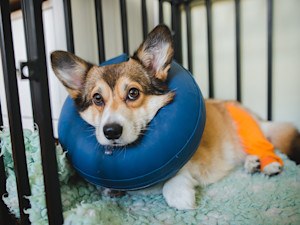Are There Alternatives to the ‘Cone of Shame’?
If your pet is recovering from surgery and hates wearing a cone, don’t panic
My long-legged Lurcher Ziggy, light of my life, can be a little over-enthusiastic sometimes. After recent surgery, I had a conundrum to face when my vet handed us a large, plastic Elizabethan collar for him to wear post-operation.
Experience told me that this wouldn’t end well. Years ago, after cutting his paw during a bout of zoomies, Ziggy was ‘helped’ into a ‘cone of shame’ while still drowsy. Once the drugs had worn off, he rushed from pillar to post as if pursued by a poltergeist, bumping into doorways and bouncing off the sofa as he tried to outrun his adversary. It was awful.
Invented in the 1960s by vet Dr Frank L Johnson and named after the ruffled collars the Tudor court of Elizabeth I favoured, the recovery cone is a simple way to keep pets safe after surgery. Placed around your pet’s neck, it prevents them from licking wounds and stitches, risking infection and further vet care.
But getting your pet to wear them isn’t always easy.
So, why do pets need recovery collars?
Recovery collars are vital in the recovery of your pet after certain medical procedures. If your vet says your pup needs to wear one, then your pup has to wear one, or you need to work with your vet to find a suitable alternative. Veterinary surgeon Dr Katie Ford, MRCVSopens in new tab understands my dilemma. “It’s important we consider animal welfare in recovery, while being sensible about wound healing,” she says.
“Pets are curious about wounds but allowing them to lick can slow healing and introduce bacteria. A collar can stop them scratching or licking while wounds heal and treatments start working.”
Dr Ford points out that a cone can prevent further vet bills down the line, avoiding restitching, delayed healing or the need for medicines like antibiotics.
“I’ve seen many animals not bother with their wound in front of the owner, but once a collar was off overnight, they reopened the area.”
If your pet has come home with a cone, Dr Ford has a few safety tips and says you should work with your vet team to check the collar is correctly fitted.
“Ensure the collar is snug enough to prevent removal but loose enough to allow two fingers to fit between the collar and your pet’s neck. I’d also recommend you monitor your pet to spot any potential problems. Unless the cone is purposefully attached to the existing collar, remove that while they’re wearing a recovery device to prevent entanglement. But if your dog is allowed out on a walk with a cone, pop their collar and ID tag back on,” says Ford.
What if my dog doesn’t like their recovery collar?
What if, despite you patiently explaining all the reasons why they need to wear the collar, your dog is still a nervous Nellie like mine?
“Unfortunately, dogs are introduced to a recovery collar when they already feel rubbish,” says accredited dog trainer and behaviourist Joe Nutkinsopens in new tab. “In an ideal world we would introduce them to the cone over a few sessions before they need it.”
“If your dog is booked for surgery, spend time beforehand helping your dog get used to the collar. There’s a high chance a dog will need one at some point, so you could train your dog with the cone just in case.”
Whether you’ve been able to prep your dog or not, Joe has some advice.
“If there’s a choice of collars, try them on to see which is more comfortable for your dog,” says Joe. “The bigger the cone, the heavier and more restrictive it is, so assess which size they need.”
“Then, start by putting the cone on your dog for a moment, praise and reward your dog then take it off, and make a game of it. Then put it on for a little longer with praise, strokes, treats, a chew, a favourite toy, then take it off again,” says Joe.
“While the cone is first on, do something with your dog that they enjoy, give them a fuss, help them eat a chew stick or take them for a walk if allowed.”
“Also, guide your dog through a few doors to show them they can get through, and in and out of the house for the toilet, etc. It’s likely they will be tired but briefly showing them what they are able to do can help,” says Joe.
And if a cone sill isn’t an option?
Dr Ford says, “Some animals find a collar stressful, with peripheral vision affected, and some will struggle to reach their food and water bowls. Poorly fitted collars can cause irritation, and a collar might even upset other pets in the house.”
Ziggy isn’t alone in being both physically and mentally less suited to cone-wearing either. “The traditional cones might not suit dogs with long and slender necks like a Lurcher. Brachycephalic breeds, like Pugs and Bulldogs, might struggle with breathing, drinking or eating in a cone, and very small or toy breeds may struggle with the collar’s weight being a problem.”
“Some very energetic pets might end up damaging the collar if they constantly crash into their surroundings.”
There’s even scientific evidence to suggest Ziggy isn’t the only one – quite literally – making a song and dance out of wearing a cone. A new studyopens in new tab by the Sydney School of Veterinary Science found pet parents reported a worse quality of life for their pets while wearing the collar. It impacted the animal’s sleeping, eating, drinking, exercise and interactions. And the researchers discovered many pet parents were reluctant to use the collar because of this. Reported collar-related injuries from this study included falling downstairs, with animals running at furniture to try to remove the collar. The researchers suggested that “where possible, alternative methods of preventing self-trauma should be explored.”
So, it’s a relief when Dr Ford says, “Let’s normalise having a conversation about all options, rather than plastic Elizabethan collars being the first and only option.”
“Every patient is an individual, and there are now a bunch of alternatives to the traditional plastic cone.” So, don’t panic if you‘re at the end of your tether. Instead, sit down with your vet and see if they can offer any alternative suggestions.
Alternatives to the Elizabethan collar
The fabric collar
This is an Elizabethan collar made of soft, padded fabricopens in new tab. This type of collar can help reduce noise levels that the lampshade shape of the collar often amplifies when it’s made of plastic. If your pet is head sensitive, this might be a kinder option. Bonus points for waterproof, wipeable material and a design that folds flat when it’s not in use.
The inflatable collar
This design stops some animals from reaching wounds, without the need for extra-long sides that affect the field of vision. Typically, the collar has an outer coveropens in new tab than can be removed and cleaned, with an inflatable interior. Dogs with long necks or noses might still be able to reach the rest of their body with this style.
Surgical body suits
A full body recovery suitopens in new tab might suit some pets if it covers the area that needs to be protected. A surgical suit can sometimes replace the need for any type of head cone or collar, meaning your pet can relax while they heal. Speak to your vet about how to care for the wound underneath.
Customised surgical sleeves
Pets can also wear surgical ‘sleeves’opens in new tab designed to cover a specific part of their body (typically one or two legs). Again, this will protect the recovery spot without the need to use a collar. Google to see a range of designs (including those that will make your pet look as if it’s wearing trousersopens in new tab!).
This oneopens in new tab can work for a left or right front leg.
Safety first
How can you tell if your chosen alternative is safe and effective? Speak to your vet and work with them to choose the best option. They’ll have plenty of experience in the kind of recovery your pup needs and whether or not your chosen alternative to the recovery collar is adequate for their particular healing process. “If in doubt, speak to your vet,” says Dr Ford, “Ask if they think it’s suitable.”
“When using surgical collars or alternatives, monitor your pet closely, especially when you first come home or when first fitted. Ask yourself if your pet can eat, drink and breathe freely, whether they are stressed and if they can get to the wound.”
“And if your pet shows unusual behaviour, manages to reach the wound, or if the recovery aid becomes damaged, consult your vet,” says Dr Ford.








